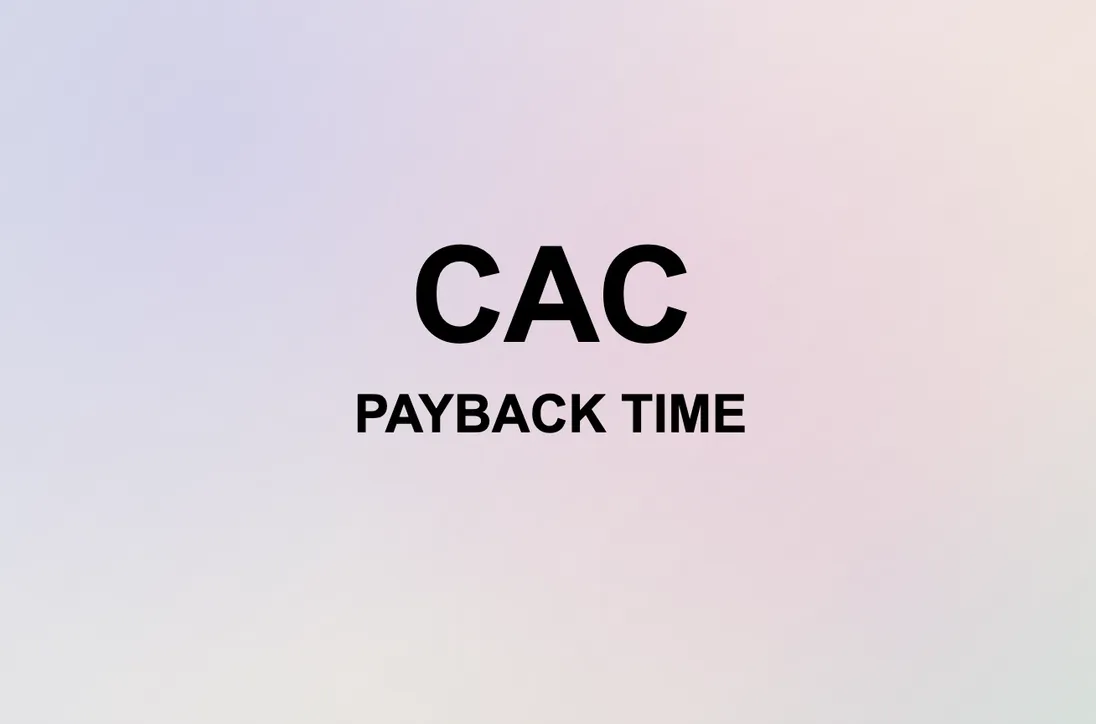How do you measure CAC payback time?

Customer acquisition cost (CAC) is one of the most important SaaS metrics, but it's only half the story. The real insight comes from knowing how long it takes to recover that cost, which is where CAC payback time comes in. Understanding it helps you evaluate growth sustainability, cash flow risk, and marketing efficiency - all critical for SaaS operators at any stage.
Yet many founders get tripped up by one subtle detail: how the customer pays. A user who pays monthly vs one who pays annually up front affects not only when your revenue hits the books but also your cash flow. We'll cover that and more in this post.
What CAC payback time actually measures
CAC payback time tells you how long it takes for the revenue from a new customer to cover the cost of acquiring them. It's a simple formula at its core:
Where:
- Customer Acquisition Cost (CAC): total sales + marketing spend divided by new customers acquired.
- ARPA: Average monthly recurring revenue per customer.
- Gross Margin: the ratio of the total revenue and the revenue minus the cost of delivering the service (hosting, support, etc.).
Here's where the nuance comes in: if a customer pays annually upfront, your revenue hits immediately, which can make CAC payback appear faster than for monthly-paying customers, even if the underlying profitability is the same. Conversely, monthly subscriptions spread revenue over time, so payback in cash terms may lag behind the accounting payback.
Why CAC payback time matters
Understanding CAC payback time matters for three big reasons:
Cash flow planning If your CAC payback is longer than your cash runway, even profitable growth can be dangerous. Annual payments can help reduce cash risk, while monthly subscriptions require more careful planning.
Marketing and sales efficiency Short payback indicates high ROI on your acquisition channels. Long payback can signal overspending, inefficient targeting, or a sales process that takes too long.
Growth strategy decisions Some companies accept longer payback for enterprise deals or high-LTV segments. Understanding the interaction of payment timing, churn, and gross margin helps you decide how aggressively to scale.
Example: a $1,000 CAC customer paying $250/month gross margin recovers the CAC in 4 months. If that same customer pays $3,000 annually upfront, payback in cash is 1 month, but the underlying economics are identical - just the timing differs.
How to calculate CAC payback step by step
Determine CAC Total sales + marketing spend over a period divided by new customers acquired. Example: $60,000 spent acquiring 100 customers → CAC = $600/customer.
Calculate gross margin per month Monthly revenue minus the cost of delivering the service. Example: $200 monthly revenue – $50 cost of service → $150 gross margin/month.
Adjust for payment terms
- Monthly subscriptions: use the monthly gross margin directly.
- Annual upfront payments: either divide by 12 to get effective monthly gross margin or calculate payback in months of cash inflow, which can show faster payback.
Apply the formula
CAC Payback Time = 600 / 150 = 4 months
Note on upfront payments: if the same customer pays for a full year upfront ($200 × 12 = $2,400), the cash comes in faster, so the business recovers the $600 CAC in just 1 month of cash inflow. For accounting purposes, the monthly gross margin is still $150, so the "accounting payback" remains 4 months.
- Segment by cohort or channel
Cohort analysis helps identify which acquisition channels, payment plans, or campaigns deliver faster payback.
Common pitfalls
- Ignoring churn: CAC payback assumes customers stick around long enough to cover acquisition cost. If churn is high, payback may never happen.
- Using revenue instead of gross margin: Always subtract the cost of serving the customer. Otherwise, payback is overstated.
- Blended CAC: Aggregating across channels hides inefficiencies. Compare CAC payback by channel.
- Mixing payment frequencies: Monthly vs annual payments can skew cash vs accounting payback if not tracked properly.
Benchmarks for SaaS businesses
Payback expectations vary by business model:
- Early-stage, self-serve SaaS: 3–6 months. Cash flow is critical, so shorter payback is better.
- Mid-market SaaS: 6–12 months. Customers pay more, but the acquisition cycle is longer.
- Enterprise SaaS: 12–24 months can be acceptable if LTV is high. Annual contracts can improve cash payback significantly.
The key takeaway: faster payback is better, but context matters. Payment terms, churn, and gross margin all influence how quickly CAC is recovered in cash and accounting terms.
How GrowPanel helps
GrowPanel simplifies CAC payback tracking:
- Automatically calculate CAC and gross margin per cohort.
- Track monthly vs annual subscriptions separately.
- Combine CAC payback with churn, expansion, and contraction for a full revenue picture.
- Use predictive analytics to anticipate payback for new cohorts or channels.
With GrowPanel, you can see both the accounting payback and cash payback, helping finance and growth teams plan effectively without manual spreadsheets.
Key takeaways
- CAC payback time measures how quickly a customer's revenue covers acquisition cost.
- Always use gross margin, account for churn, and consider cohort differences.
- Monthly vs annual payments affect cash flow payback; annual upfront can make payback appear faster.
- Use CAC payback alongside LTV and churn to make informed growth decisions.
- GrowPanel makes calculating and tracking CAC payback straightforward, with segmentation and predictive insights built in.
Next steps: Pull your CAC, gross margin, and churn metrics in GrowPanel. Segment by payment frequency and acquisition channel, calculate payback, and use these insights to optimize marketing spend and growth strategy.

Lasse Schou
Lasse is the founder of GrowPanel and an entrepreneur with 25 years of experience building SaaS businesses. After a successful exit from his previous SaaS company, he now invests as an angel in promising SaaS startups.

